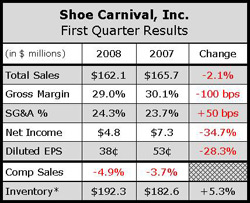Although overall first quarter results were generally dismal, Shoe Carnival became the latest family footwear chain to point to resurging sales in the athletics category, citing particular strength in women's. Adult athletics comps increased low-singles while overall comps declined 4.9% due to particular weakness in sandals and open up dress shoes.
Shoe Carnival became the latest family footwear chain to point to resurging sales in the athletics category, citing particular strength in women's. Adult athletics comps increased low-singles while overall comps declined 4.9% due to particular weakness in sandals and open up dress shoes.
“Although there continues to be no fashion drivers in the women's non-athletic, we did see positive comparable store sales increases in our athletic business for the quarter, particularly in women's athletic,” said Cliff Sifford, EVP and GMM, on a conference call.
Key athletic classifications and vendors standing out were skate and performance running along with Nike, Asics and Converse. Sifford said that Shoe Carnival plans to fund those athletic shoe vendors “that have proven to us that the customer recognizes their product for performance and value.” As examples, he mentioned Nike, Asics, Converse and New Balance as examples.
“We have already seen some positive results of this strategy for spring as we have driven higher out the door retails in every department except women's non-athletic,” said Sifford.
Sifford also attributed part of Shoe Carnival's current positive trend in athletic to the initiative first started a year ago addressing a lack of fashion product for the African American and Hispanic consumers in the family channel.
“Several styles have been delivered and we are happy with the results,” said Sifford. “These results give us confidence. As we see economic conditions improve for this customer, we will be well positioned to be the destination store and our channel for fashion athletics.”
Mark Lemond, president and CEO, was likewise pleased to “see some life out of the athletic business right now” and expects to see this continue through the back-to-school period, “especially with the summer Olympics falling right in the middle of this important sales period.”
Women's non-athletic department saw a double-digit comp decline due to a lack of fashion, the very early Easter, and cooler weather. The 0.8% merchandising margin decline was largely a result of promotional selling in women's casual and sandals.
A new VP/DMM of women's non-athletics has been hired and buyers have been reassigned to revive the business. Men's non-athletic was down very low-single-digits, while kids sales were flat.
Regarding pricing pressures stemming from China, Shoe Carnival expects, on average, cost increases of between 5% and 15% for the fall season. The company does not anticipate these cost increases moderating until the Chinese factories have had a full year to factor in the new labor laws enacted this past February.
“We recognized that due to this inflationary pricing and current economic conditions, we will sell fewer pairs in 2008 than we did in 2007,” Sifford said. “In order to succeed, the pairs we do sell must be sold at higher retails. Our strategy to meet this goal is to add value to our women's non-athletic product with better materials, more comfort features and even more brands.”
An overhaul of its marketing initiatives resulting from the hiring of SVP of marketing, Todd Beurman, and a new ad agency are expected to help drive traffic. A new customer loyalty program and new look for its website are expected to launch in the latter half of this year.
Customer traffic continued to decline during the first quarter, but conversion and average transaction increased.
Shoe Carnival continues to plan conservatively given the difficult climate. Average comp inventories are being planned down high-single-digits for the balance of 2008.
“Our merchants will remain focused on decreasing inventory levels per store and improving the turnover and gross margin return on investment,” said president and CEO, Mark Lemond. “Our plan is to allow inventories per store to fall throughout the remainder of the year thus generating cash flow and protecting gross profit margins.”
>>> Improving athletic? Famous Footwear had also reported an improvement in athletics in the first quarter.















